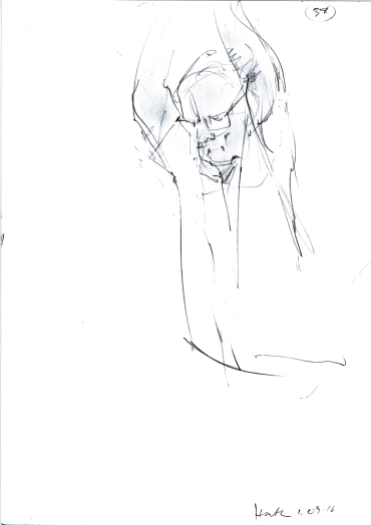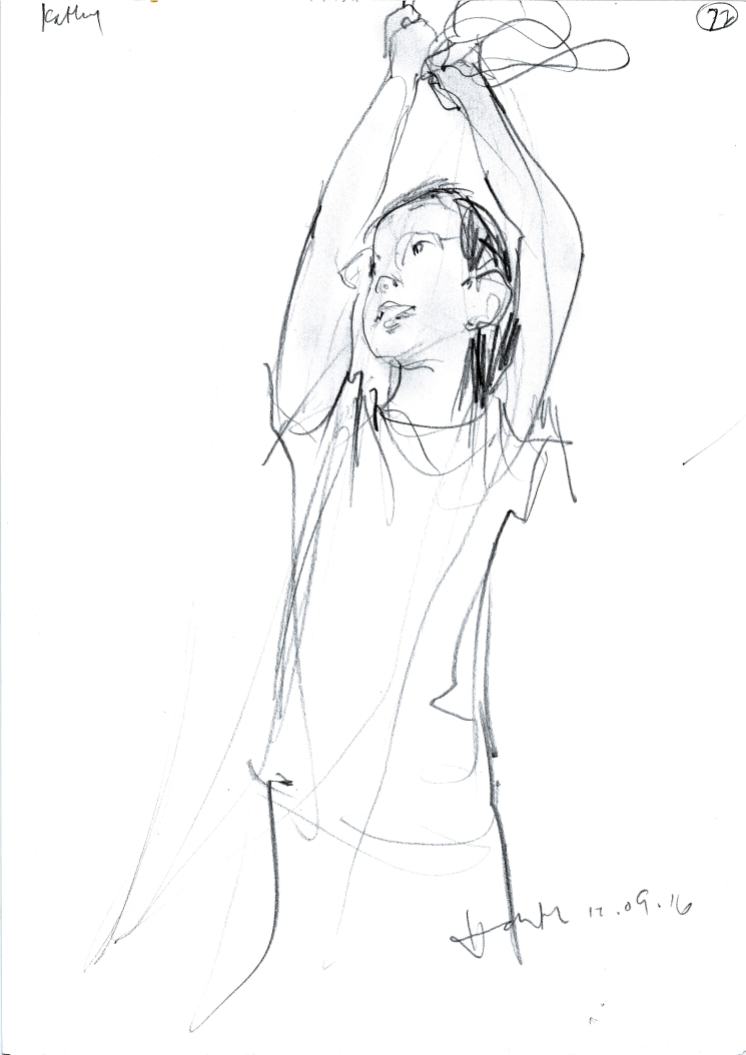Blog 7 – Drawing bell-ringers
Thanks to Tegnerne’ (Graphic Artists’) Copyright Fund I was able to take an exhibition to Oxford and spend 5 weeks there in August and September 2016. My birth- and neonatal drawings were hung in the gallery at the John Radcliffe Hospital. I also planned to draw there, but administrative haggling about permissions took time, so instead I started drawing bell ringers – something I had long wanted to do.
Thus I got to experience Oxford in a very special way. By climbing up into the beautiful bell towers I was entering a centuries-old tradition which still thrives in England. As a subject for drawing it was perfect for me – human figures in concentrated motion, fast, beautiful and very difficult to draw.
The bells are reached by narrow, almost vertical stairs or ladders, or spiral stone steps with a rope to cling to. Up there is the belfry with its great, heavy bells, and the space is limited indeed. I stood in a corner or sat on a stone sill, careful to avoid the bell ropes which hung through holes in a half-loft to insulate the sound. Each bell has its own name and tone – there can be 6 or even 11 – the sullen, latent ropes hung bound over in loose knots, and the ringers ecognized each one. Ready, they loosened the ropes and stood in a circle, each grasping a taut rope over their heads. The Master of the Peals under his certain bell called, ”Treble’s going – she’s gone!” and at the last word he pulled downward with all his strength, everyone followed in order, and the loft was filled with an enormous and earsplitting – yet known and defined – clamor. The ancient well-known melodies each have a name and difficulty.
I learned something of the special jargon or vocabulary of bell ringers, and gradually came to feel a powerful sense of the long, unbroken tradition these dedicated musicians share.
Afterwards we went to the pub, where I enjoyed their stories and their pride in being accomplished ringers.
To draw there? For me it was that first reach and grasp, the physical effort of pulling the great bell down to strike, that captured me – I wanted to learn this, to see it and draw it, while all was in movement around me. The old bells are very heavy and it takes strength and concentration – and that was visible.
Through the nearly 100 drawings I managed to make, you can see how I had to look with all my attention – the first drawings show many repeated lines – in the last, made just before I had to go back to Denmark – have become more simple. I was just beginning to catch it.
At the start one can ask oneself, “How can you draw motion, effort, so it doesn’t just look like someone standing there holding a rope?” I could go on about how the artist’s line, our divine tool, is the perfect instrument to convey motion. But that is another story.
Dégas wrote: “Art is not invention, art is repetition.” And it’s true.
For this reason it is pretty hopeless to go out into the world to draw (favorite places are a park, a gallery, a train station or a café) where people move around in a boring way and you just have to hope that someone will sit or stand still. Only through repetition can one draw the human motion we love to capture – this is how Dégas and the other great artists drew. To show students one out of hundreds of a master’s drawings and say “This is how you should draw” is cheating, and “gesture drawing” is a waste of time.
Rodin as an old man saw the first Cambodian dancers to visit Paris, and fell in love. He drew furiously, and was heartbroken when they went away. “I followed them to Marseilles. I would follow them to Africa – I would follow them to the ends of the earth.”
This is what it was like for me to leave Oxford, the city with the golden towers. Drawing in the midst of all that movement and tumult, in full concentration, I realized I was completely happy. And that is rare.
I feel as if I have just begun.









I love how you jump into new realms of experience with such gusto and willingness to explore their reality.. Experiencing bell ringers with all your senses and from what you see, feel, touch and experience it inside. Your bell ringers are fluid and solid at the same time. Your ability to tease out experience and record it is uniquely you. Thank you.
LikeLiked by 1 person
thanks dear Catherine, just saw this! look at my new blog of today on the Palestinian drawings. my new “agent” Wee Heather said I had to make one as she is trying to get me a show at the UN Copenhagen, a huge wew building on the waterfront. love Heather
LikeLike
left you a long reply but no idea where it went.
xH
LikeLike
Lovely article Heather and I just love your drawings as usual capturing movement with such apparent ease. Beautiful line that speaks so fluently.
LikeLike